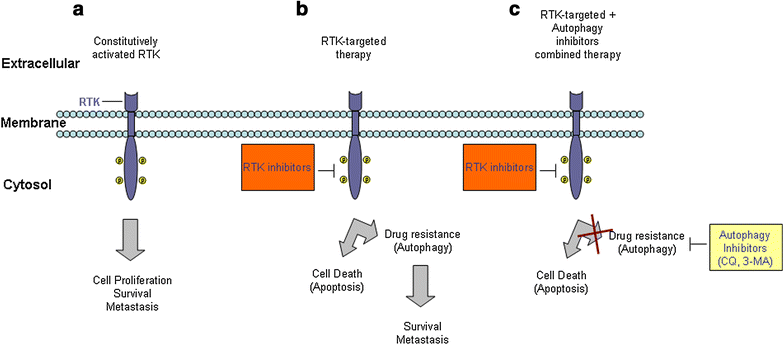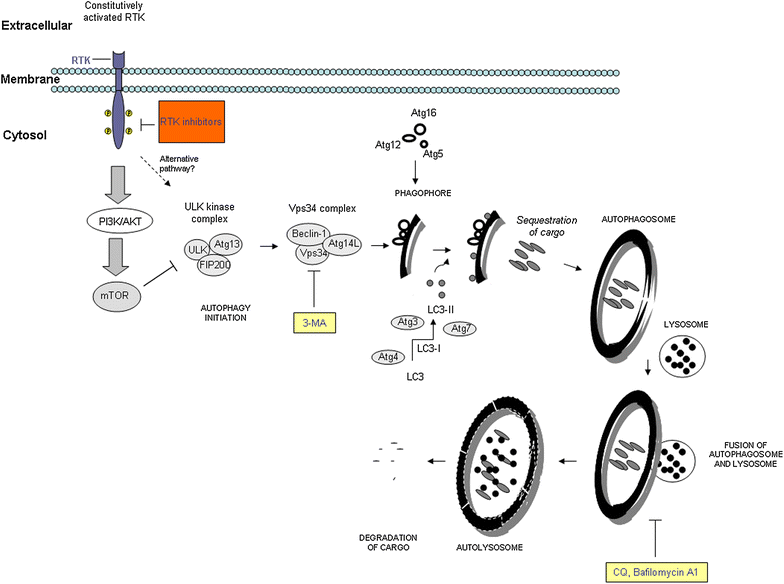Resistance to receptor tyrosine kinase inhibitors in solid tumors: can we improve the cancer fighting strategy by blocking autophagy?
- PMID: 27486382
- PMCID: PMC4970224
- DOI: 10.1186/s12935-016-0341-2
Resistance to receptor tyrosine kinase inhibitors in solid tumors: can we improve the cancer fighting strategy by blocking autophagy?
Abstract
A growing field of evidence suggests the involvement of oncogenic receptor tyrosine kinases (RTKs) in the transformation of malignant cells. Constitutive and abnormal activation of RTKs may occur in tumors either through hyperactivation of mutated RTKs or via functional upregulation by RTK-coding gene amplification. In several types of cancer prognosis and therapeutic responses were found to be associated with deregulated activation of one or more RTKs. Therefore, targeting various RTKs remains a significant challenge in the treatment of patients with diverse malignancies. However, a frequent issue with the use of RTK inhibitors is drug resistance. Autophagy activation during treatment with RTK inhibitors has been commonly observed as an obstacle to more efficacious therapy and has been associated with the limited efficacy of RTK inhibitors. In the present review, we discuss autophagy activation after the administration of RTK inhibitors and summarize the achievements of combination RTK/autophagy inhibitor therapy in overcoming the reported resistance to RTK inhibitors in a growing number of cancers.
Keywords: Autophagy; Combination treatment; Drug resistance; Receptor tyrosine kinase inhibitors.
Figures


Similar articles
-
Autophagy inhibition improves the cytotoxic effects of receptor tyrosine kinase inhibitors.Cancer Cell Int. 2018 Apr 24;18:63. doi: 10.1186/s12935-018-0557-4. eCollection 2018. Cancer Cell Int. 2018. PMID: 29713246 Free PMC article.
-
Cholesterol suppresses GOLM1-dependent selective autophagy of RTKs in hepatocellular carcinoma.Cell Rep. 2022 Apr 19;39(3):110712. doi: 10.1016/j.celrep.2022.110712. Cell Rep. 2022. PMID: 35443161
-
Broad RTK-targeted therapy overcomes molecular heterogeneity-driven resistance to cetuximab via vectored immunoprophylaxis in colorectal cancer.Cancer Lett. 2016 Nov 1;382(1):32-43. doi: 10.1016/j.canlet.2016.08.022. Epub 2016 Aug 26. Cancer Lett. 2016. PMID: 27569653
-
Splice Variants of the RTK Family: Their Role in Tumour Progression and Response to Targeted Therapy.Int J Mol Sci. 2017 Feb 11;18(2):383. doi: 10.3390/ijms18020383. Int J Mol Sci. 2017. PMID: 28208660 Free PMC article. Review.
-
Receptor tyrosine kinases: biological functions and anticancer targeted therapy.MedComm (2020). 2023 Dec 7;4(6):e446. doi: 10.1002/mco2.446. eCollection 2023 Dec. MedComm (2020). 2023. PMID: 38077251 Free PMC article. Review.
Cited by
-
Autophagy activation promotes bevacizumab resistance in glioblastoma by suppressing Akt/mTOR signaling pathway.Oncol Lett. 2018 Feb;15(2):1487-1494. doi: 10.3892/ol.2017.7446. Epub 2017 Nov 20. Oncol Lett. 2018. PMID: 29434840 Free PMC article.
-
Autophagy inhibition improves the cytotoxic effects of receptor tyrosine kinase inhibitors.Cancer Cell Int. 2018 Apr 24;18:63. doi: 10.1186/s12935-018-0557-4. eCollection 2018. Cancer Cell Int. 2018. PMID: 29713246 Free PMC article.
-
Targeting autophagy in cancer.Nat Rev Cancer. 2017 Sep;17(9):528-542. doi: 10.1038/nrc.2017.53. Epub 2017 Jul 28. Nat Rev Cancer. 2017. PMID: 28751651 Free PMC article. Review.
-
Safety and tolerability of quizartinib, a FLT3 inhibitor, in advanced solid tumors: a phase 1 dose-escalation trial.BMC Cancer. 2018 Aug 6;18(1):790. doi: 10.1186/s12885-018-4692-z. BMC Cancer. 2018. PMID: 30081867 Free PMC article. Clinical Trial.
-
Pharmacological Inhibition of Brain EGFR Activation By a BBB-penetrating Inhibitor, AZD3759, Attenuates α-synuclein Pathology in a Mouse Model of α-Synuclein Propagation.Neurotherapeutics. 2021 Apr;18(2):979-997. doi: 10.1007/s13311-021-01017-6. Epub 2021 Mar 12. Neurotherapeutics. 2021. PMID: 33713002 Free PMC article.
References
Publication types
LinkOut - more resources
Full Text Sources
Other Literature Sources

